Virtual Science Museum
Scientific Instruments - Page 1 of 2
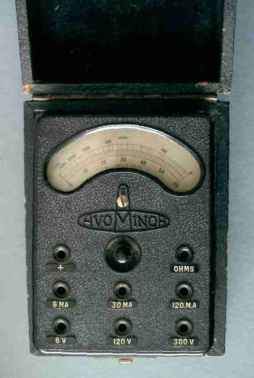 This is an Avo Minor. The Avo 8 is probably the most famous multimeter ever made.
The Avo Minor is rather rarer. This is the only one I have seen first hand. Inside
there are only 8 fixed resistors, 1 variable resistor and a 1.5V battery. Despite
its simplicity, it has 14 ranges and can measure D.C. milliamps, volts and ohms.
It dates from around 1946.
This is an Avo Minor. The Avo 8 is probably the most famous multimeter ever made.
The Avo Minor is rather rarer. This is the only one I have seen first hand. Inside
there are only 8 fixed resistors, 1 variable resistor and a 1.5V battery. Despite
its simplicity, it has 14 ranges and can measure D.C. milliamps, volts and ohms.
It dates from around 1946.
There has been quite a lot of interest in this instrument, so I have now included
the twelve page Avo Minor Manual
which was kindly provided by Megger. Please note that the Avo Minor Manual page
takes quite a long time to fully load.
Although this instrument is relatively rare, it is not particularly valuable and
they do appear on ebay from time to time.
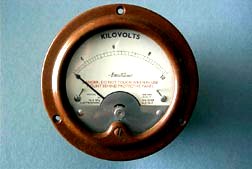 This electrostatic voltmeter is scaled from 0 to 10kV. Like the gold leaf
electroscope, the electrostatic voltmeter relies upon electrostatic force
to deflect the pointer. As a result, only a very small leakage current is
drawn from the circuit under test while the pointer is stationary.
This electrostatic voltmeter is scaled from 0 to 10kV. Like the gold leaf
electroscope, the electrostatic voltmeter relies upon electrostatic force
to deflect the pointer. As a result, only a very small leakage current is
drawn from the circuit under test while the pointer is stationary.
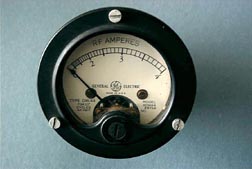 RF ammeters like this one work in quite an interesting way.
The terminal posts are connected directly together by a
short length of wire. A thermocouple is attached to the
middle point of the wire and directly drives the moving coil
meter. This particular one is designed to work up to 70MHz.
RF ammeters like this one work in quite an interesting way.
The terminal posts are connected directly together by a
short length of wire. A thermocouple is attached to the
middle point of the wire and directly drives the moving coil
meter. This particular one is designed to work up to 70MHz.
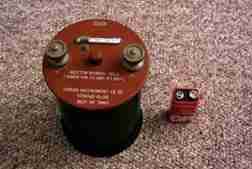 Weston normal cell produces 1.0183V at 20C. It would have been
used as a calibration standard. The voltage varies with
temperature, hence the built-in thermometer. The 9V battery is for scale.
Weston normal cell produces 1.0183V at 20C. It would have been
used as a calibration standard. The voltage varies with
temperature, hence the built-in thermometer. The 9V battery is for scale.
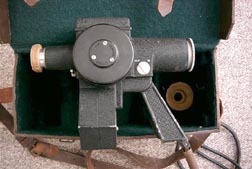 This is an optical pyrometer of the disappearing filament type.
The user looks through the device at the item to be measured. The
filament power is then adjusted until it appears the same
colour and intensity as the object. The temperature of the object
is then read from the meter (if the user has not gone blind by
this stage).
This is an optical pyrometer of the disappearing filament type.
The user looks through the device at the item to be measured. The
filament power is then adjusted until it appears the same
colour and intensity as the object. The temperature of the object
is then read from the meter (if the user has not gone blind by
this stage).
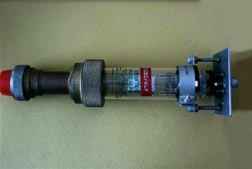 This is an ionization gauge head for measuring very low pressures. Ion
gauges typically cover the pressure range from 10-3mbar to
10-8mbar. The device is basically a triode and relies on the
phenomenon that at low pressures, the number of positive ions produced
by electron collision is proportional to the product of pressure and
current. The left hand end connects to the vacuum system.
This is an ionization gauge head for measuring very low pressures. Ion
gauges typically cover the pressure range from 10-3mbar to
10-8mbar. The device is basically a triode and relies on the
phenomenon that at low pressures, the number of positive ions produced
by electron collision is proportional to the product of pressure and
current. The left hand end connects to the vacuum system.
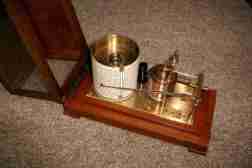 This Met Office Barograph records atmospheric pressure over a
seven day period. The drum which holds the chart contains a
wind-up clock mechanism which rotates it at the correct speed.
A liquid ink pen, driven up and down by bellows records the
pressure on the drum as it rotates.
This Met Office Barograph records atmospheric pressure over a
seven day period. The drum which holds the chart contains a
wind-up clock mechanism which rotates it at the correct speed.
A liquid ink pen, driven up and down by bellows records the
pressure on the drum as it rotates.
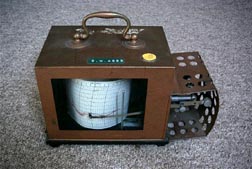 This thermograph is the temperature equivalent of the barograph.
The only difference is that is uses a bi-metallic coil to move the
pen instead of bellows.
This thermograph is the temperature equivalent of the barograph.
The only difference is that is uses a bi-metallic coil to move the
pen instead of bellows.
I have created a chart for this thermograph which can be printed on high
quality ink jet paper or plotter paper:
Thermograph_Chart.pdf
 This is an Avo Minor. The Avo 8 is probably the most famous multimeter ever made.
The Avo Minor is rather rarer. This is the only one I have seen first hand. Inside
there are only 8 fixed resistors, 1 variable resistor and a 1.5V battery. Despite
its simplicity, it has 14 ranges and can measure D.C. milliamps, volts and ohms.
It dates from around 1946.
This is an Avo Minor. The Avo 8 is probably the most famous multimeter ever made.
The Avo Minor is rather rarer. This is the only one I have seen first hand. Inside
there are only 8 fixed resistors, 1 variable resistor and a 1.5V battery. Despite
its simplicity, it has 14 ranges and can measure D.C. milliamps, volts and ohms.
It dates from around 1946. This electrostatic voltmeter is scaled from 0 to 10kV. Like the gold leaf
electroscope, the electrostatic voltmeter relies upon electrostatic force
to deflect the pointer. As a result, only a very small leakage current is
drawn from the circuit under test while the pointer is stationary.
This electrostatic voltmeter is scaled from 0 to 10kV. Like the gold leaf
electroscope, the electrostatic voltmeter relies upon electrostatic force
to deflect the pointer. As a result, only a very small leakage current is
drawn from the circuit under test while the pointer is stationary. RF ammeters like this one work in quite an interesting way.
The terminal posts are connected directly together by a
short length of wire. A thermocouple is attached to the
middle point of the wire and directly drives the moving coil
meter. This particular one is designed to work up to 70MHz.
RF ammeters like this one work in quite an interesting way.
The terminal posts are connected directly together by a
short length of wire. A thermocouple is attached to the
middle point of the wire and directly drives the moving coil
meter. This particular one is designed to work up to 70MHz. Weston normal cell produces 1.0183V at 20C. It would have been
used as a calibration standard. The voltage varies with
temperature, hence the built-in thermometer. The 9V battery is for scale.
Weston normal cell produces 1.0183V at 20C. It would have been
used as a calibration standard. The voltage varies with
temperature, hence the built-in thermometer. The 9V battery is for scale. This is an optical pyrometer of the disappearing filament type.
The user looks through the device at the item to be measured. The
filament power is then adjusted until it appears the same
colour and intensity as the object. The temperature of the object
is then read from the meter (if the user has not gone blind by
this stage).
This is an optical pyrometer of the disappearing filament type.
The user looks through the device at the item to be measured. The
filament power is then adjusted until it appears the same
colour and intensity as the object. The temperature of the object
is then read from the meter (if the user has not gone blind by
this stage).
 This Met Office Barograph records atmospheric pressure over a
seven day period. The drum which holds the chart contains a
wind-up clock mechanism which rotates it at the correct speed.
A liquid ink pen, driven up and down by bellows records the
pressure on the drum as it rotates.
This Met Office Barograph records atmospheric pressure over a
seven day period. The drum which holds the chart contains a
wind-up clock mechanism which rotates it at the correct speed.
A liquid ink pen, driven up and down by bellows records the
pressure on the drum as it rotates. This thermograph is the temperature equivalent of the barograph.
The only difference is that is uses a bi-metallic coil to move the
pen instead of bellows.
This thermograph is the temperature equivalent of the barograph.
The only difference is that is uses a bi-metallic coil to move the
pen instead of bellows.